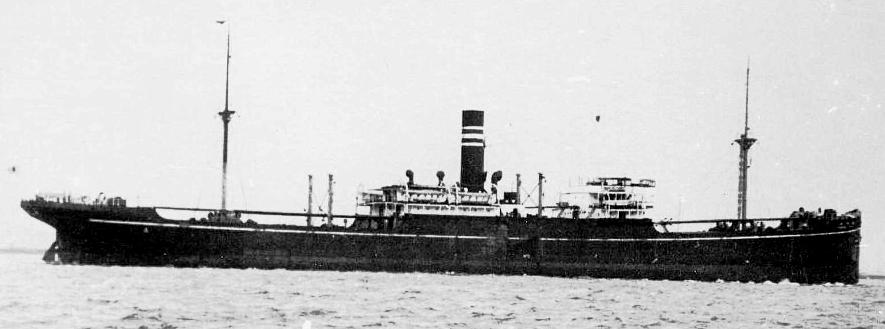RIKUGUN YUSOSEN
 (TSURUGA MARU, prewar)
(TSURUGA MARU, prewar)
IJA Transport TSURUGA MARU:
Tabular Record of Movement © 2013-2017 Bob Hackett
8 March 1916:
Nagasaki. Laid down at Mitsubishi Shipyard as Yard No. 250, a
7,289-ton cargo ship for Nippon Yusen Kaisha (NYK), K. K. (Japan Mail Steamship
Co.).
28 April 1916:
Launched and named TSURUGA MARU.
15 June 1916:
Completed. and placed until the outbreak of the Pacific
War.
1918-1920:
In NYK's cargo service from Havana,
Cuba~-Barry~Middlesbrough, England to New York.
8 August 1920:
TSURUGA MARU departs Kobe for Hamburg, Germany via
Yokohama, Moji and London.
22 December 1933:
TSURUGA MARU departs Singapore, Malaya (now
Malaysia) for Hong Kong, Moji . Kobe, Osaka and Yokohama.
20 October 1934:
TSURUGA MARU departs Singapore for Hamburg, Germany
via Colombo, Ceylon (now Sri Lanka), Suez, Port Said, Eqypt, London, England and
Rotterdam, Netherlands.
25 August 1937:
Requisitioned by the Imperial Army (IJA) and
converted to a troop transport. Alloted IJA No. 304.
30 March 1938:
Released by the IJA back to her owners.
21 July 1941:
Re-requisitioned by the IJA.
22 December 1941:
TSURUGA MARU departs Davao in the Jolo Occupation
Convoy also consisting of IJA transports, HAVANA, KURETAKE, TEIRYU (ex-German
AUGSBURG) and TSURUGA MARUs and IJN transports KOSHIN and NICHIAI MARUs and EIKO
MARU No. 2 and an unidentified transport.
The convoy carries about 4,000 men consisting of the Sakaguchi Detachment
(56th Mixed Infantry Corps, Matsumoto Detachment of the 146th Infantry Regiment,
1st Field Artillery Battalion, the Miura Detachment of the 16th Army Division,
IJN 3rd Airfield Construction Unit, engineer and communications units and the
Kure No. 1 Special Naval Landing Force (SNLF).
The convoy is escorted by DesRon 2's light cruiser JINTSU and DesDiv 15's
HAYASHIO, KUROSHIO, NATSUSHIO and OYASHIO. Carrier RYUJO and seaplane tenders
CHITOSE and SANUKI MARU provide air cover.
24 December 1941: The Invasion of Jolo, Philippines.
At 2000, the
landings on Jolo, Philippines begin.
25 December 1941:
At 1030, Jolo, including its airfield, is secured.
Jolo provides a forward base for supporting the attacks on Borneo.
26 December 1941:
The first IJN fighters land on Jolo. Later, another
seaplane base is also set up at Jolo.
6 January 1942: The Invasion of Tarakan, Dutch Borneo:
At 1100, Rear
Admiral (later Vice Admiral) Hirose Sueto´s (39) Tarakan Occupation Force Convoy
departs Daliao (13 km SW of Davao).
The convoy is organized into two subdivisions:
1st subdivision (right
wing unit) consists of Army transports TSURUGA, LIVERPOOL, EHIME. HANKOW, HITERU
and HANKOW MARUs and Navy transports KUNIKAWA and KANO MARUs carrying MajGen
Sakaguchi Shizuo’s 56th Mixed Infantry Group (Sakaguchi Detachment) right wing
forces and the No. 2 Kure Special Naval Landing Force (SNLF).
2nd
subdivision (left wing unit) consists of Army transports HAVANA, TEIRYU,
KURETAKE, NICHIAI MARUs and Navy transports KAGU, KUNITSU and RAKUTO MARUs and
carrying the Sakaguchi Detachment 's left wing forces, 5th Construction Unit and
2nd Defense Unit.
The escort is provided by Rear Admiral (later Vice Admiral) Nishimura
Shoji’s DesRon 4’s light cruiser NAKA with DesDiv 2’s HARUSAME, SAMIDARE,
YUDACHI and MURUSAME, DesDiv 9’s ASAGUMO and MINEGUMO, NATSUGUMO and DesDiv 24’s
UMIKAZE, KAWAKAZE, YAMAKAZE and SUZUKAZE. 21st Air Flotilla seaplane tenders
SANUKI and SANYO MARUs provide air cover.
Hirose's force also includes MineSweepDiv 11’s W-16, W-15, W-13, W-14,
MineSweepDiv 30’s W-17 and W-18, SubChasDiv 31’s CH-10, CH-11 and CH-12, patrol
boats P-36, P-37 and P-38 and other auxiliary ships.
10 January 1942:
At 1900, both subdivisions arrive at No. 1 Anchorage.
At 2215, the 2nd subdivision including TEIRYU MARU departs No. 1 Anchorage.
11 January 1942:
At 0100, arrives at No. 2 Anchorage At 0220, the
landing barges cast off from the transport ships and head towards the landing
zone on the SE coast of Tarakan.
21 January 1942: The Invasion of Balikpapan, Dutch Borneo:
At 1700,
Rear Admiral Hirose's Balikpapan Invasion Convoy departs Tarakan, Borneo
carrying the Balikpapan Invasion Force consisting of the Sakaguchi Detachment
(56th Regimental Group) and Kure No. 2 SNLF escorted by patrol boats PB-36,
PB-37, PB-38, minesweepers W-15, W-16, W-17, W-18 and SubChasDiv 31's CH-10,
CH-11 and CH-12.
The convoy is organized into two subdivisions:
1st subdivision
consists of Army transports TSURUGA, LIVERPOOL, HITERU and EHIME MARUs
(Sakaguchi Detachment), Navy transports ASAHISAN and NITTEI MARUs (2nd
Construction Unit), KUMANOGAWA MARU (1st Base Force auxiliary ammunition ship)
and SUMANOURA MARU (1st Base Force auxiliary netlayer).
2nd subdivision
consists of Army transports HAVANA, HANKOW, TEIRYU and KURETAKE MARUs (Sakaguchi
Detachment), Navy transports KANAYAMASAN MARU (2nd Construction Unit), FUJIKAGE
(TOEI) MARU (1st Defense Unit) and NANA MARU (11th Air Fleet Transport).
Cover is provided by light cruiser NAKA (F) with DesDiv 2's YUDACHI,
SAMIDARE, MURASAME, HARUSAME, DesDiv 9's ASAGUMO, MINEGUMO, NATSUGUMO and DesDiv
24's KAWAKAZE and UMIKAZE. Seaplane tenders SANUKI and SANYO MARUs provide air
cover.
Poor weather hampers air reconnaissance by ABDA
(American-British-Dutch-Australian) forces, but ABDA Air finally locates the
invasion force. Rear Admiral (later Vice Admiral) William A. Glassford's Task
Force 5's light cruisers USS MARBLEHEAD (CL-12), BOISE (CL-47) and Cdr Paul H.
Talbot's DesDiv 59's old destroyers USS PARROTT (DD-218), POPE (DD-225), JOHN D.
FORD (DD-228) and PAUL JONES (DD-230) are ordered to stop the invasion force,
but BOISE runs aground and MARBLEHEAD develops engine trouble. DesDiv 59 is
detached and increases speed to arrive at Balikpapan at midnight on January
23rd.
24 January 1942: Dutch Navy LtCdr C. A. J. van Well Groeneveld's (former
CO of HMNS K-XIV) submarine HMNS K-XVIII, operating on the surface due to the
weather, fires four bow torpedoes at light cruiser NAKA, but they all miss. At
0045, Groeneveld again fires at NAKA, but misses and hits TSURUGA MARU port
amidships, sinking her at 00-10N, 118-0E. 38 troops and one crewman are KIA.
Author's Notes:
Thanks go to Erich.Muehlthaler of Germany.
Bob Hackett
Back
to IJA Transports





